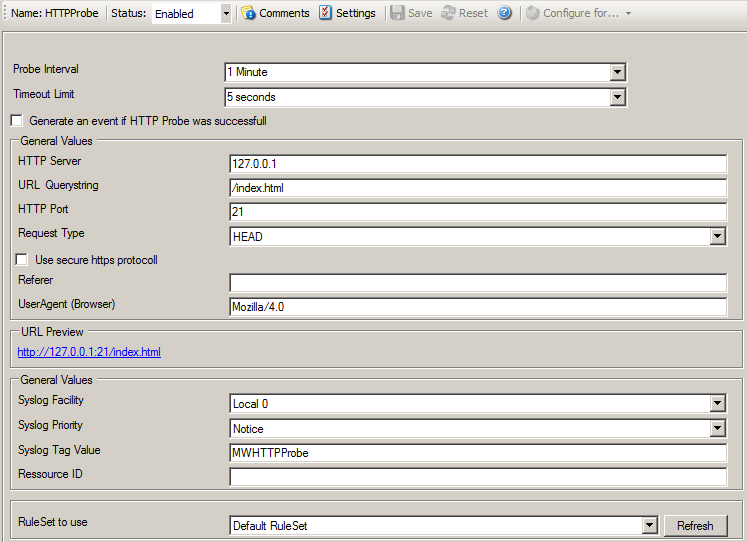The HTTP Probe connects to a HTTP Server, and sends a valid HTTP request as configured. It then either receives the header or header and content of a website, depending on how the service is configured (See Request Type).

HTTP Probe Properties
Probe Interval
This is the interval of the HTTP probes. After each probe, the MonitorWare Agent 3.0 HTTP probe process goes "to sleep". This period is specified in milliseconds.
Timeout Limit
The amount of time (in milliseconds) the remote system is expected to answer in. If no response is received within this period, the HTTP probe fails and an event is generated. The default value of 1000 milliseconds is a proper value for most well connected networks. If the HTTP probe runs against a heavily loaded system and/or slow network link, the amount must be adjusted accordingly.
Generate an event if HTTP Probe was successful
When checked, an event is generated every time. If unchecked, it is generated only when the HTTP probe fails. The most common option is to leave it unchecked to catch events upon a failed HTTP probe.
HTTP Server
Either the IP address or resolvable host name of the HTTP server, the HTTP probe is to be run against. You can either use an IPv4, an IPv6 Address or a Hostname that resolves to an IPv4 or IPv6 Address. Please note that specifying a host name can cause the HTTP probe to fail if DNS name resolution fails (for example due to a failing DNS server). To avoid this, specify an IP address.
Url & QueryString
By default this is /index.html. This value is used to construct an URL which is previewed in a rectangular field under Use secure https Protocol option.
Port
This port is to be probed. Please see your server's reference for the actual value to use. For example, mail servers typically listen to port 25 and web servers to 80.
Request Type
The Request Type can be HEAD or GET. HEAD just receives the header of a website where GET receives the whole website content. When probing a web server, you should use HEAD in order to reduce network and processing overhead.
Use secure https Protocol
You can enable this option, if you want to query a web server using SSL (Secure Socket Layer). Note that the default port is changed from 80 to 443 here.
Referrer
An optional configuration option where you can specify a Referrer that is send in the HTTP header.
UserAgent (Browser)
It is also an optional value which can be used to specify an UserAgent that is send in the HTTP header.
Syslog Facility
The Syslog facility to be assigned to events created by this service. Most useful if the message is to forward to a Syslog server.
Syslog Priority
The Syslog priority to be assigned to events created by this service. Most useful if the message is to forward to a Syslog server.
Resource ID
The Resource ID to be assigned to events created by this service. Most useful if the message is to forward to a Syslog server.
Syslog Tag Value
The Syslog tag value to be assigned to events created by this service. Most useful if the message is to forward to a Syslog server.